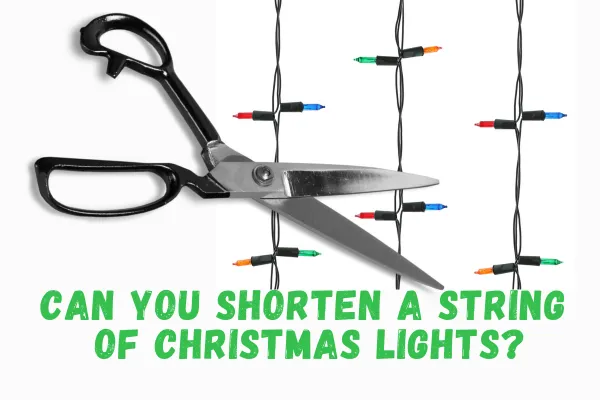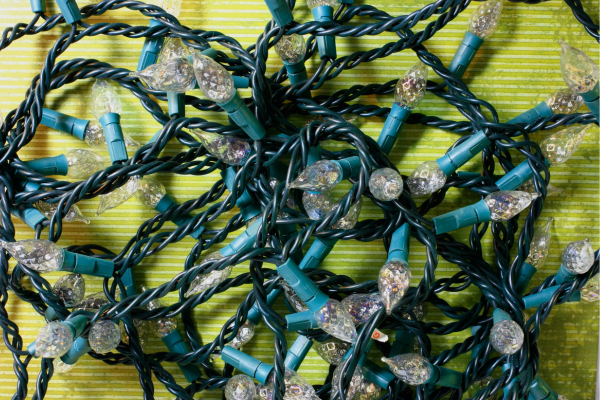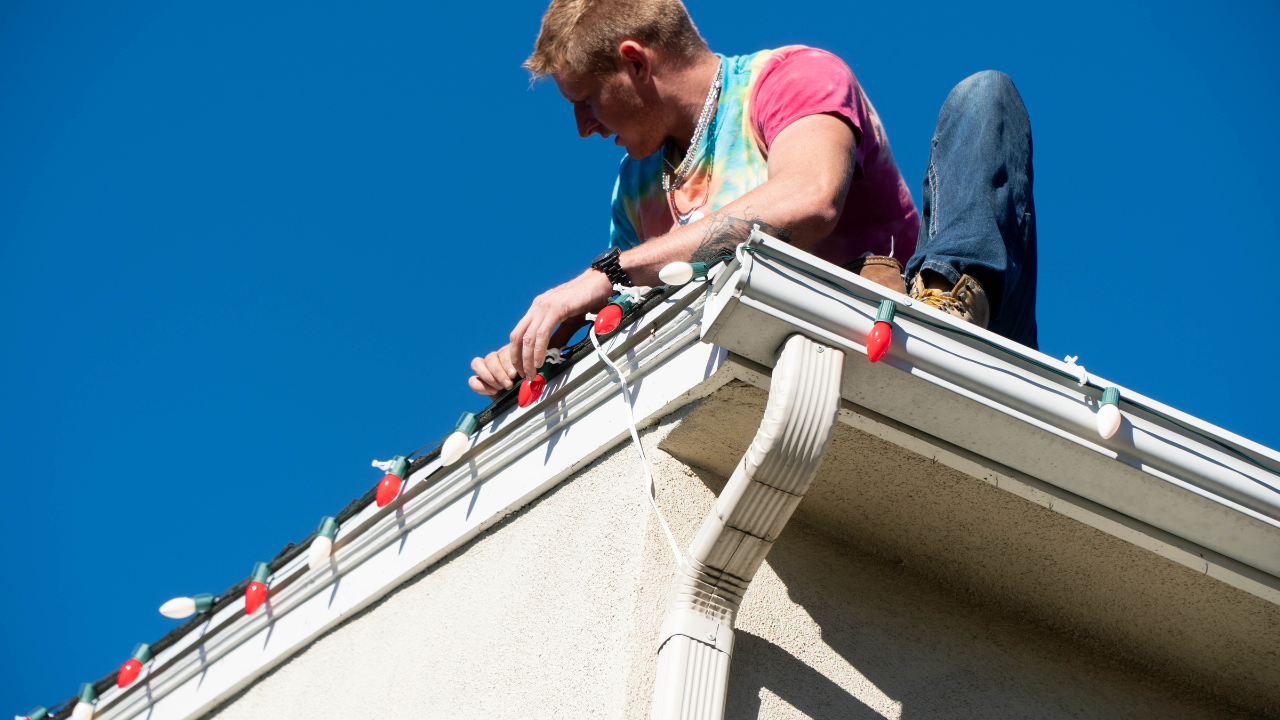Podcast

Can You Shorten a String of Christmas Lights?
Just by chance, you've been wrestling with that extra-long strand of Christmas lights and wondering, 'Can I just shorten this?' Hold on before you grab those scissors, though. It's not as simple as snipping and rejoining; such alterations could negatively affect the string's performance and lifespan.
Both incandescent and LED lights have particular specifications, and tampering with them might do more harm than good. So, stay tuned as we explore safer and more efficient alternatives to help your Christmas light display shine without the extra length.

Understanding Christmas Light Strings
Before you attempt to modify your Christmas lights, it's crucial to understand that standard string lights aren't designed to be safely and effectively shortened. This fact might seem inconvenient, especially when you've got a specific design or space in mind, but there's a lot more to string length than just aesthetics.
When manufacturers design these lights, they consider bulb ratings, string length, and power requirements. Each bulb in the string has a specific rating that directly relates to the total length of the string. If you start messing with the length, you're also messing with the electrical balance, which could lead to performance issues.
Moreover, it's not just about performance. There are significant safety concerns as well. When you alter the string length, you're potentially creating a fire hazard. The current flowing through the string can become too high for the wire to handle, leading to overheating and possibly a fire. It's not something you'd want to risk, especially during the festive season.
Risks of Shortening Light Strings
Diving into the risks of shortening light strings, it's important to realize that you're not just compromising the longevity of your lights, but potentially inviting a safety hazard into your home. The temptation to take a pair of scissors to that unwieldy length of lights might be strong, yet it's a DIY solution that could lead to serious electrical safety issues.
When you alter a string of lights, you're tampering with an established electrical circuit. This can result in potential hazards such as shock or fire. Not to mention, it could also compromise the insulation protecting the wiring, making your festive display a dangerous one.
Moreover, you're risking the light performance. The brightness of your lights might diminish or they might flicker incessantly. This is because each bulb in the chain is designed to receive a specific amount of current. Altering this flow can mess with the way your lights glow.
Lifespan concerns are another factor. You've probably noticed how a string of lights tends to burn out all at once. That's because the bulbs are interconnected. When you shorten a string, you're influencing the lifespan of not just one, but all the bulbs in the chain.
In the end, while shortening a string of Christmas lights might seem like a simple DIY solution to a common problem, the risks far outweigh the convenience. It's always safer and smarter to find an alternative way to manage the extra length. Remember, safety should always outshine aesthetics.

Incandescent Lights Specifics
When it comes to incandescent lights, it's crucial to understand they've specific ratings for length and the number of bulbs. Each bulb has its own voltage requirement, which is determined by the overall length of the string. Exceeding these length limitations can lead to potential hazards such as overheating or electrical shorts.
Bulb requirements are also a key factor. The wattage of each bulb is calculated based on the total string length and voltage. Adding or removing bulbs can change the voltage distribution, risking bulb burnout or possible fire. It's crucial to keep the original number of bulbs intact to maintain the safe operation of your lights.
Safety precautions are paramount when dealing with incandescent lights. Always ensure your lights are unplugged before making any adjustments. Never leave your lights unattended while they're on, especially if you've made modifications. Remember, it's always better to be safe than sorry.
Voltage considerations are another important aspect. The total voltage of the string should never exceed the rated voltage of the individual bulbs. If you're considering shortening your light string, you must also consider voltage changes and their potential implications.
Impact on LED Lights
Just like with incandescent lights, tampering with LED lights can also have serious implications on their functionality and safety. You may think you're doing a simple hack to fit your decorative needs, but improper modification can lead to several problems, including reduced lifespan and potential damage to the lights.
When you attempt to shorten your LED string lights, you're essentially meddling with their designed structure. LED lights are specifically designed with a certain number of bulbs and length for optimal performance. Cutting through them can cause performance issues, as you're disrupting the way they're meant to work. Each bulb in the string has a specific function and removing any of them can lead to imbalances in the circuitry.
Additionally, the safety concerns can't be ignored. The wiring in LED lights is designed to handle a certain amount of current. If you shorten the string, you're disrupting this balance, which could potentially cause the lights to overheat and create a fire hazard. Not to mention, your attempts at modification could expose you to the risk of electric shock if not done correctly.

Why Avoid Shortening Lights
Given these potential hazards and performance issues, it's clear why you should avoid attempting to shorten your string lights. The safety concerns are paramount. When you tamper with your Christmas lights, you're not just risking damage to the lights themselves, but you're also creating a potential fire hazard.
The lifespan effects are another reason for avoiding modifications. Whether you're dealing with incandescent bulbs or LED lights, these lights are designed to last for a specific number of hours. By tampering with them, you're likely to reduce their lifespan significantly.
Then there are the performance issues to consider. Strings of lights are carefully engineered to ensure that the electricity is evenly distributed among the bulbs. If you alter the length of the string, you can disrupt this balance, leading to dimmer lights or even causing some bulbs to burn out prematurely.
The potential damage can go beyond just your lights. If you're not careful, you could also cause damage to your home. For instance, if you cut a string of lights and don't properly seal the ends, moisture could seep in and cause a short circuit. This could, in turn, damage your home's electrical system.

Alternatives for Shorter Display
So, if cutting down your string lights isn't a safe or viable option, how can you create a shorter light display without compromising on safety and performance? There are several creative solutions.
Firstly, consider compact displays. Instead of spreading lights out over a large area, why not focus them in a smaller, more concentrated space? This could mean wrapping lights around a small tree, a wreath, or a centerpiece. The light arrangement in a compact area may create a more intense, festive effect.
Secondly, you can wind up the extra length of lights. If you find yourself with a string that's too long, try doubling it up. Loop the lights back and forth, effectively halving the length. This creates a denser, brighter display.
Thirdly, if you're struggling to find a space for the extra length, hiding the additional bulbs can be a viable space-saving option. You can tuck the extra bulbs behind your display or in areas that aren't easily visible. This way, you're not wasting any lights and your display remains the desired length.
Lastly, consider exploring other decorative possibilities. For instance, use the extra lights to accentuate other parts of your home or garden. Wrap them around banisters, mirrors, or plant pots.

What Safety Precautions Should Be Taken While Handling Christmas Light Strings?
When handling Christmas light strings, always prioritize electrical safety to avoid fire hazards.
Before you begin, inspect the insulation for any damage. If you spot a broken bulb, replace it promptly.
For outdoor placement, ensure the lights are specifically designed for exterior use. Don't overload your circuits and remember to turn off the lights when you're not around.
Safety should always come first, so be mindful while decorating.
Can You Connect Multiple Shorter Strings of Lights Together to Create a Longer Display?
Yes, you can connect multiple shorter strings of lights to create a longer display. It's a smart move for lighting aesthetics and can help with bulb replacement and power consumption.
You'll have more decoration ideas and better light synchronization. However, be mindful of the power load on your circuits and always follow manufacturer's guidelines for the number of strings that can be safely connected together.
How Can I Store My Christmas Lights to Ensure They Last Longer?
To extend your Christmas lights' lifespan, proper storage is crucial. Avoid temperature extremes; they can damage the bulbs and wiring.
Keep them dry to prevent moisture damage. Carefully package them to avoid tangling and breaking.
Having bulb replacements on hand is also smart, as the occasional bulb will burn out. With these steps, you'll get more life out of your Christmas lights.
What Are the Best Brands for Long-Lasting Christmas Light Strings?
You're looking for long-lasting Christmas light brands. Consider those with LED durability, bulb brightness, and energy efficiency. Brands like GE, Philips, and Brizled are known for these traits.
They also offer various light color options, allowing you to personalize your display. Don't forget to check for weather resistance too, ensuring your lights can withstand the elements.
Make the right choice and you won't need to worry about shortening or replacing your Christmas lights anytime soon.
Are There Any Eco-Friendly Alternatives to Traditional Christmas Lights?
Yes, there are several eco-friendly alternatives to traditional Christmas lights. You can opt for solar alternatives or LED lights, which are more energy-efficient. Recycled decorations are a great choice too.
Also, consider using biodegradable options or setting up energy-efficient displays. Remember, every small step you take towards sustainability makes a big difference.

So, can you shorten a string of Christmas lights?
Technically, yes, but it's not recommended. Tampering with your lights can harm their performance and shorten their lifespan.
Whether they're incandescent or LED, each string has specific ratings and requirements.
Instead of risking your festive glow, why not try alternatives like using shorter strings, winding up the extra, or hiding spare bulbs? For more ideas, see our blog post: The Best Way to Hang Christmas Lights.
With a bit of creativity, you can enjoy a hassle-free holiday light display.
Copyright ©2025 All Right Reserved website designed by christmaslights.io
Terms of Service / Privacy Policy
Have questions or need assistance?
Contact us at (855)619-LITE


